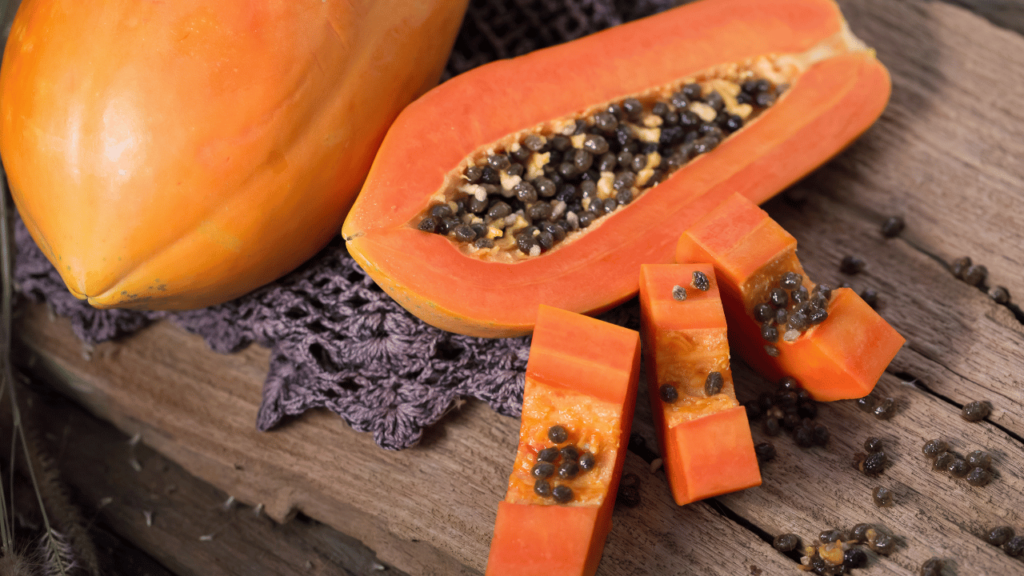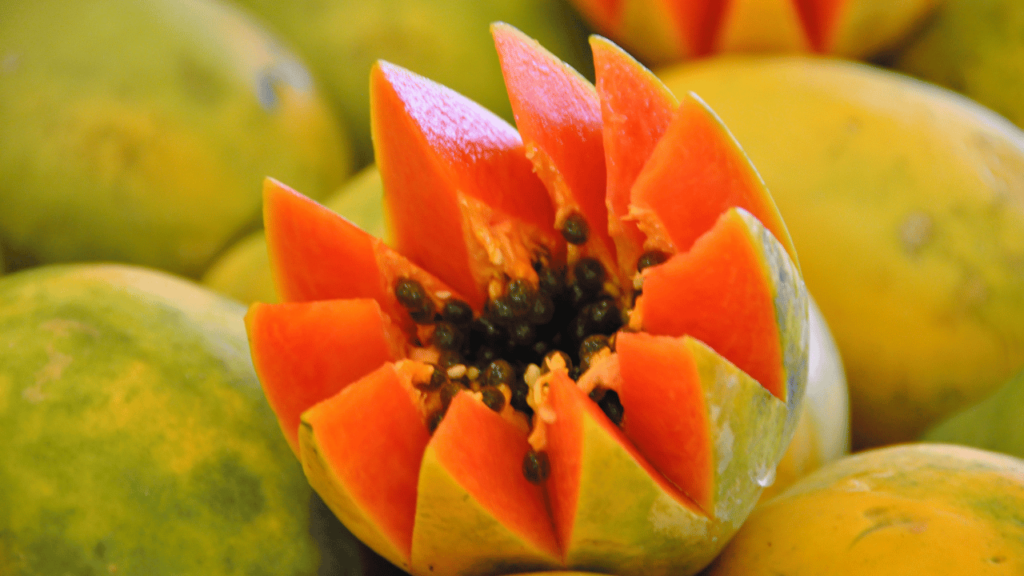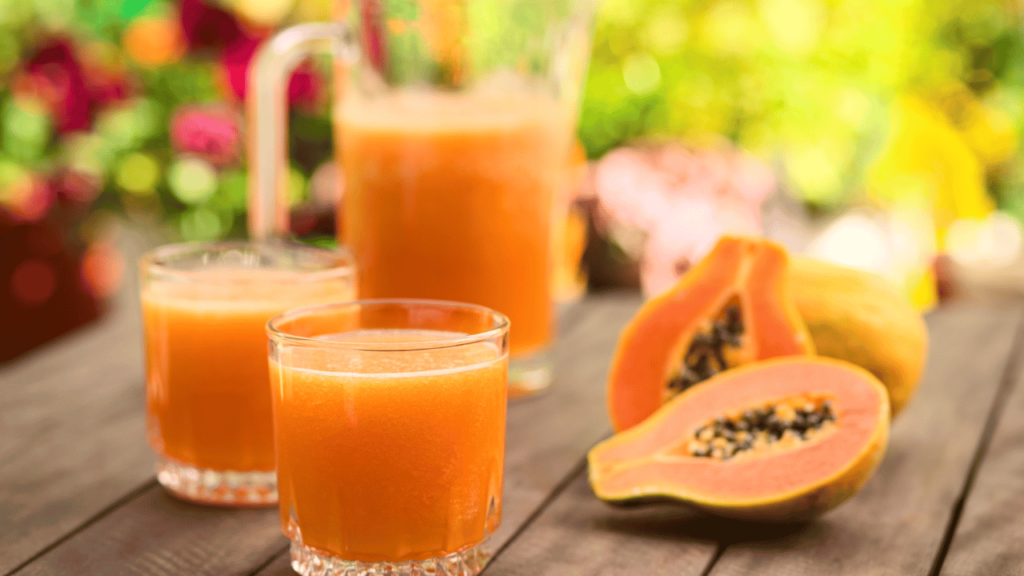Fresh Papaya Unveiled: Exploring Benefits and Side Effects in 2023
Fresh Papaya
Fresh Papaya Unveiled: Exploring Benefits and Side Effects in 2023. Fresh Papaya is a tropical fruit indigenous to Central America and Mexico. It has a unique oblong shape and can vary in size, ranging from small to large. The skin of the papaya is thin and smooth, and it can be green when unripe and turn yellow or orange as it ripens.

When you cut open a papaya, you’ll find a vibrant orange or pink flesh with small black seeds in the center. The flesh is soft, and juicy, and has a sweet flavor with a hint of tropical notes. Some people describe the taste as a mix of melon, mango, and citrus.
Not only is papaya delicious, but it is also rich in nutrients. It’s a great source of vitamin C, vitamin A, folate, and dietary fiber. Additionally, it harbors an enzyme known as papain, contributing to digestive support.
How does Papaya grow?
Papaya trees grow in tropical and subtropical regions, where the climate is warm and sunny. They prefer well-drained soil and can tolerate a variety of soil types. The process of growing papaya starts with planting the seeds or transplanting young papaya trees into the ground.
Once planted, papaya trees require regular watering and plenty of sunlight to thrive. They can grow quite tall, reaching heights of up to 30 feet. The tree’s trunk is soft and hollow, while the leaves are large and palm-like.

Papaya trees are unique because they have male and female flowers on separate plants. The female flowers develop into the fruit, while the male flowers produce pollen for pollination. In some cases, certain papaya trees can have both male and female flowers, making them self-pollinating.
It takes several months for papaya fruit to develop and ripen. The fruit starts green and gradually changes color as it matures. When the papaya is ready to be harvested, it will have a vibrant yellow or orange hue, depending on the variety.
Cultivation Of Papaya
Fresh Papaya is found in many countries around the world, especially in tropical and subtropical regions. It is commonly grown in countries such as Mexico, Brazil, India, Indonesia, Thailand, Nigeria, and the Philippines. These countries have the ideal climate and conditions for papaya to thrive. However, papaya is also cultivated in other parts of the world, including the United States, Australia, and various countries in Africa and South America. It’s amazing how this delicious fruit has spread across different corners of the globe.
How to cut papaya?
To cut a papaya, follow these steps:
- Start by washing the papaya thoroughly under running water to remove any dirt or impurities.
- Place the papaya on a cutting board and use a sharp knife to slice off both ends.
- Stand the papaya upright on one of the cut ends and carefully peel the skin from top to bottom, following the curve of the fruit. You can also use a vegetable peeler for this step.
- Once the skin is removed, cut the papaya in half lengthwise.
- Use a spoon to scoop out the seeds from the center of each half. You can discard the seeds or save them for planting if you’d like.
- Now, you can slice the papaya into desired shapes. You can cut it into cubes, or slices, or even scoop it out with a melon baller for a more decorative presentation.
And there you have it! You’re ready to enjoy your freshly cut papaya.
Types Of Papaya
There are several types of papaya, each with its unique characteristics and flavors. Some popular varieties include:
- Solo Papaya: Also known as Hawaiian Solo or Sunrise papaya, this variety is small to medium in size, with vibrant orange flesh and a sweet, tropical flavor. It’s commonly found in Hawaii and other tropical regions.
- Maradol Papaya: This type of papaya is larger, with a greenish-yellow skin that turns yellow when ripe. The flesh is deep orange and has a sweet, juicy taste. Maradol papayas are often grown in Mexico and other Central American countries.
- Tainung Papaya: This variety is known for its high yield and resistance to diseases. It has a medium to large size, with yellow skin and sweet, flavorful flesh. Tainung papayas are commonly cultivated in Taiwan and other Asian countries.
- Red Lady Papaya: As the name suggests, this papaya variety has a reddish-orange flesh. It is smaller in size compared to other types and has a sweet, aromatic flavor. Red Lady papayas are cultivated in various tropical regions, including India and Thailand.
These are just a few examples of the different types of papaya you might come across. Each variety has its unique taste and characteristics, so feel free to explore and discover your favorite.
Benefits Of Papaya
here are some benefits of papaya in points with more details:
- Rich in Vitamin C: Papaya is an excellent source of vitamin C, which is essential for a strong immune system, collagen production, and healthy skin.
- Supports Digestion: Papaya contains an enzyme called papain, which aids in digestion by breaking down proteins and improving nutrient absorption. It can help alleviate digestive issues like bloating and constipation.
- Promotes Heart Health: The fiber, potassium, and antioxidants in papaya contribute to heart health.
Its fiber content contributes to reducing cholesterol levels, while the presence of potassium assists in regulating pressure. The antioxidants protect against oxidative stress, reducing the risk of heart disease. - Anti-Inflammatory Properties: Papaya contains several compounds with anti-inflammatory properties, such as flavonoids and beta-carotene. These compounds can help reduce inflammation in the body and may benefit conditions like arthritis.


- Supports Eye Health: The high levels of vitamin A and beta-carotene in papaya promote good vision and overall eye health. They can help prevent age-related macular degeneration and reduce the risk of cataracts.
- Boosts Skin Health: The antioxidants in papaya help fight free radicals and protect the skin from damage. Regular consumption of papaya can improve skin elasticity, reduce wrinkles, and promote a healthy complexion.
- Aids Weight Loss: Papaya is low in calories and high in fiber, making it a great choice for weight management.
The fiber content helps maintain a prolonged feeling of fullness, reducing the likelihood of overeating. - Supports Hair Health: The vitamins and minerals in papaya, such as vitamin A, vitamin E, and folate, promote healthy hair growth and prevent hair loss. The antioxidants also help protect the scalp from damage.
So, those are some of the amazing benefits of papaya, It’s a delicious and nutritious fruit to add to your diet.
Side Effects
Papaya is generally safe to consume, but some people may experience side effects, especially if consumed in large quantities. Here are a few potential side effects of papaya:
- Allergies: Certain people might experience allergic reactions to papaya, manifesting as itching, swelling, hives, or respiratory difficulties. If you experience any of these symptoms after eating papaya, it’s best to consult a doctor.
- Digestive Issues: Papaya contains an enzyme called papain, which can help with digestion. However, for some people, consuming excessive amounts of papaya or taking papaya enzyme supplements may lead to digestive issues such as diarrhea or an upset stomach.
- Latex Allergy: People who are allergic to latex may also be allergic to papaya. This is known as latex-fruit syndrome. If you have a latex allergy, it’s advisable to exercise caution when consuming papaya.
- Blood Thinning: Papaya contains a compound called papain, which has blood-thinning properties. While this can be beneficial for some individuals, it may not be suitable for those who are already taking blood-thinning medications. It’s important to consult a healthcare professional if you have any concerns.
As with any food or dietary supplement, it’s always a good idea to consume papaya in moderation and listen to your body. If you have any specific health concerns or medical conditions, it’s best to consult with a healthcare professional for personalized advice.
Famous Dishes Of Papaya
Papaya proves to be a versatile fruit suitable for incorporation into a variety of dishes. Here are a few popular dishes that feature papaya:
- Papaya Salad: A refreshing and tangy salad made with shredded green papaya, lime juice, fish sauce, chili peppers, and a mix of herbs and vegetables. It’s a popular dish in Thai cuisine known as “Som Tam.”
- Papaya Smoothie: Blend ripe papaya with some yogurt, ice, and a touch of honey for a delicious and nutritious smoothie. For an extra burst of flavor, consider incorporating other fruits such as banana or pineapple.
- Papaya Salsa: Combine diced papaya with tomatoes, onions, cilantro, lime juice, and a dash of chili for a tropical twist on traditional salsa.
It complements grilled fish or chicken exceptionally well. - Papaya Boat: Cut a ripe papaya in half lengthwise and remove the seeds. Fill the cavity with a mixture of yogurt, granola, fresh berries, and a drizzle of honey. It’s a delightful and healthy breakfast or snack option.
These are just a few examples, but there are many more creative ways to incorporate papaya into your dishes.
Can you freeze fresh papaya?
Yes, you can freeze fresh papaya! Freezing papaya is a great way to preserve its freshness for a longer period. Here’s how you can do it:
- Start by washing and peeling the papaya, just like you would if you were cutting it.
- Cut the papaya into desired shapes, such as cubes or slices.
- Lay the papaya pieces in a single layer on a baking sheet lined with parchment paper or a silicone mat. Make sure the pieces are not touching each other.
- Place the baking sheet in the freezer and let the papaya pieces freeze for a few hours, or until they are completely frozen.
- Once the papaya pieces are frozen, transfer them into a freezer-safe bag or airtight container. Label the container with the date for future reference.
- Put the container back in the freezer and store the frozen papaya for up to 6 months.
Frozen papaya can be used in smoothies, desserts, or as a refreshing snack. Just thaw the desired amount in the refrigerator or at room temperature before using.
Fresh papaya juice
Fresh papaya juice is a delicious and refreshing drink! To make it, you’ll need ripe papayas, a blender, and a strainer. Here’s a simple recipe:
- Start by cutting the papaya in half lengthwise. Remove the seeds by scooping them out and discard.
- Peel the skin off the papaya and cut it into chunks.
- Place the papaya chunks into a blender and blend until smooth.

- If you prefer a smoother texture, strain the juice through a fine-mesh strainer to remove any pulp or fibers.
- You can add a squeeze of lime juice or a drizzle of honey for extra flavor if you’d like.
- Pour the fresh papaya juice into a glass, add ice if desired, and enjoy!
Papaya juice is not only delicious but also packed with vitamins and antioxidants. An excellent method to stay refreshed and hydrated.